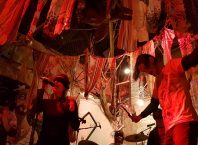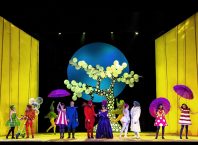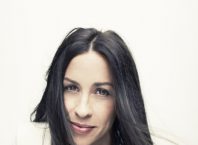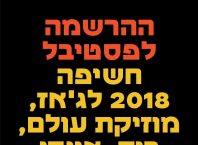By Ayelet Dekel
“You see more coverage of modern dance than science in the newspaper,” smiles Dr.
Ayelet Baram-Tsabari, lecturer of Biology Education and Science Communication at the Technion, as we sit over cappuccinos, talking about the uneasy relationship between science and the media in Israel. Her comment is certainly true of Midnight East, which, as a magazine focusing on culture is perhaps exempt from her censure. However, there is a serious lack of science coverage more generally in Israel. As pointed out by Baram-Tsabari, her own field – Science Communication – is almost non-existant as a field of research in Israel, and there are no full-time science writers in any of the mainstream media, while she reports that “In the Egyptian newspaper Al-Ahram there are twenty [full-time science writers].” Baram-Tsabari explains why we should fear and fight the current situation, and sends a message to scientists: “You need to stop being afraid.”
What are scientists afraid of? Baram-Tsabari explains that scientists often hesitant to communicate their research to the media for fear that it will be misinterpreted and simplified to the point of distortion. Yet she says, “I don’t think that it is a problem if you place things in the proper context. If you explain things, people will understand.” Why does she think it is so important to discuss science in the media? Baram-Tsabari begins by noting that it is important to the scientists because “the public, the Israeli taxpayer, supports their research. From a moral perspective, there is the issue of transparency, it is important that the results of the supported research be known, otherwise, people might think that investing in scientific research is a mistake.”
“Most people don’t go to hear lectures at the science museum; science is almost invisible in the public media. It’s a dangerous situation because people can end up thinking that scientific research leads nowhere. They have difficulty making the connection between scientific research and the fact that they can surf the internet with several windows open at once.”
Baram-Tsabari fears for the future of science and democracy, saying, “I am afraid that scientists will continue to march forward until one day they look back and realize that no one is following. The camp will not be there. People will not have any trust in basic science. People expect to make decisions about the future – many of these decisions will have a strong background in the sciences. How will people make these decisions if they don’t have the tools and ability to understand the issues involved?”
Information on science is available for those who seek it. English language sites such as Nature, Science and The Future of Things, as well as Hebrew language sites such as Hayadan and Roey Tzezana’s Different Science offer well-written, well-researched information. Yet Baram-Tsabari says, “That’s not what I am talking about. What do people see when they open the newspaper?” Her objective is not only to make science information available to those who seek it, but to make it part of the information people receive daily, as a matter of course in the surrounding media environment. To make her point, she asks, “Can you imagine a newspaper without a reporter covering Maccabee Tel Aviv?”
As an educator, Baram-Tsabari is creating change at the source: educating scientists in communicating with the media. She is well-suited to the task with extensive experience in both fields, having worked as science advisor, reporter, editor and presenter in diverse Israeli media, including Globes, Blazer, and Channels 8, 10 and 2. For the past three years she has offered the course “Science Communication: Theory and Practice” for which she received an award for excellence in teaching in the spring of 2009. The course is open to students of all levels and department affiliation at the Technion and in addition to theory, places a great deal of emphasis on practice, giving students hands-on experience in writing about science.
The first assignment is to write an item for nature news. The articles are uploaded to a forum where students can submit comments. Every article is reviewed by two other students, then revised and re-submitted – the first step in learning to be attentive to readers. As the students are from different departments, they are exposed to writing and/or reading about topics outside their field of expertise, an experience similar to that of a layperson reading a science article in the newspaper. Writing of his experience of the course, one undergraduate student commented, “The first thing I realized was the vast gap between what interests me, as a physicist, and what is of interest to the public…how crucial it is to explain the human aspect to the discover, why it is important or useful to the world, more so than explaining the discovery itself.” A Ph.D. students writes of the difficulty a writer with expertise in a particular field may encounter in distinguishing between what is “obvious” for her, as someone with expertise in a particular field, and what is obvious to someone lacking in that background.
The second challenge faced by the students is interviewing a scientist. This is where, according to Baram-Tsabari, they learn that “it’s hard to be a journalist.” Some of the undergraduates even had difficulty finding a scientist willing to be interviewed. One undergraduate wrote of the experience, “I learned how difficult it is to quote an interviewee faithfully. Although his words are available to me, I need to select the words that will serve the reader and the process of presenting the subject in the text, without rendering a disservice to the person I am interviewing and his words.” Taking science communication to its ultimate goal – actually communicating with the public – Avital Lahav of YNET selects the best articles to post on the site. Some recent examples are
Maya Kallir-Merav’s interview with Dr. Opher Donchin who heads the Motor Learning Laboratory at Ben Gurion Univerity and Michael Shalit’s interview with doctoral candidate Dafna Levanoni on her research on Einstein’s General Theory of Relativity. Their final task is to film a news item, for which they work in groups.
In her aim to facilitate communication between science and the media, Baram-Tsabari has initiated two conferences on science communication. The first took place in March 2009 at the Technion, and the second was held December 24, 2009, in the context of the jubilee events of the Israel Academy of Science and Humanities, saying, “I am very happy that the Israeli National Academy of Science recognizes the importance of the topic.” In addition to educating scientists, she would also like “to educate the journalists to see that the ‘other side’ does not have horns.”
More dance than science on Midnight East? Yes, but readers can expect to see more science, too.
Image credit: Ilan Pilo, Avital Baer, Ayelet Baram-Tsabari, Prof. Eilam Gross at the 2nd Science Communication Conference, Israeli Academy of Science and Humanities, Dec 2009/Photo: Sasson Tiram






Great to read this! I can get you infinite access to scientists who wanna talk about their work..
Comments are closed.